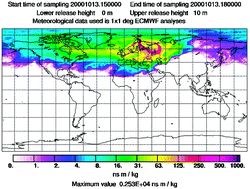A first medium term monitoring of atmospheric transport and distribution for persistent organic pollutants (POPs) in Bjørnøya (Bear island) air samples has been performed in the period between week 51/1999 and week 28/2003. A total of 50 single compounds consisting of polychlorinated biphenyls (33 congeners), hexachlorobenzene (HCB), hexachlorocyclohexane isomers (α-, β-, γ-HCH), α-endosulfan, cyclodiene pesticides (chlordanes, nonachlor-isomers, oxy-chlordane, heptachlor and chlordane) as well as dichlorodiphenyltrichloroethane (DDT) derivatives were analysed and quantified. Atmospheric transport of POPs was identified as an important contamination source for the island. PCBs, HCB and HCH isomers were the predominant POP groups, contributing with 70–90% to the overall POP burden quantified in the Bjørnøya air samples. The highest concentration levels for a single compound were found for HCB (25–35 pg m−3). However, the sum of 33 PCB congeners was found to be in the same concentration range (annual means between 15 and 30 pg m−3). Cyclodiene pesticides, DDT derivatives and α-endosulfan were identified as minor contaminants. Several atmospheric long-range transport episodes were identified and characterised. Indications for industrial emissions as well as agricultural sources were found for the respective atmospheric transport episodes. A first simple statistical correlation assessment showed that for long-range transport of pollution, the local meteorological situation is not as important as the air mass properties integrated over the time period of the transport event. The local weather situation, on the other hand, is important when investigating deposition rates and up-take/accumulation properties in the local ecosystem. Based upon chemical data interpretation, valuable information about the influence of primary and secondary sources on the air mass contamination with chlorinated insecticides (e.g., HCHs) was found and discussed. The interdisciplinary interpretation of contaminant data using statistical methods, chemical analysis, meteorological modelling and classical meteorological information for a comprehensive evaluation of atmospheric long range transport into the European Arctic (Bjørnøya) has proven to be a highly versatile tool not only for atmospheric scientists but also with strong potential for regulatory purposes.


 Please wait while we load your content...
Please wait while we load your content...